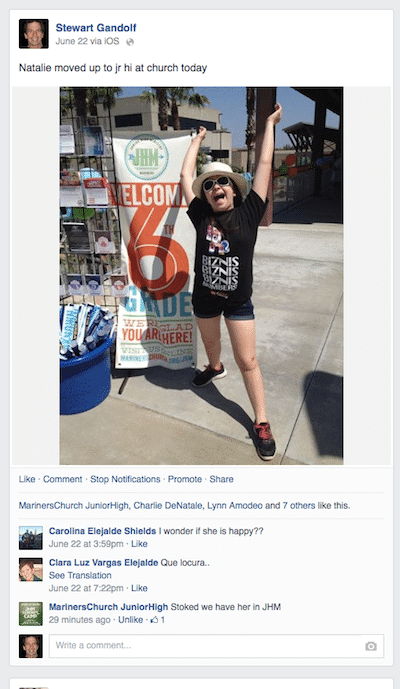Social Media Marketing Lessons From My Kids’ Jr High Ministry

Right up front I want you to know that this post isn’t about religion. Once in a while we step away from healthcare marketing to connect readers with good ideas from other fields, to keep things interesting and to give new perspectives. And for this case example, I talked with Justin Herman, the Jr. High Pastor at Mariners Church in Irvine, CA. In a brief chat, you quickly realize that Justin is a marketing-savvy guy who knows how to use social media tools to interact with his audience.
One of the keys to success—for this ministry or for any organization—is when interactivity happens within the group. Social media helps make that connection. About 300 students participate in the junior high program each weekend. In addition, there are events, school programs and activities during the week. And students who don’t attend on a given weekend are still connected to the program.
“We use social media tools,” Justin told me, “because we want students to connect with the program in real time. Social media is immediate. We are able to show things, and students can share their experience, in near real time. When that happens, excitement spreads and others want to participate similarly or the next time.
Without engagement, it’s not really social…
“Our target audience is mainly the kids in the group, but social sharing also involves others, such as their friends who don’t yet belong, as well as parents. Social media is way to instantly leverage the immediacy—“the now”—of the program and the healthy things they have to share with peers.
“Social media is just that; it is social. You post something, someone engages and responds and interaction begins. Social media is meant to be a back and forth.”

“Studies tell us that 95 percent of people would be willing to go to church if they were invited by a friend. Students invite students,” Justin explained. “Plus social media to shows parents that this is a program that they can trust.”
As I talked with Justin about the continued success of his program, some of the social media tips that anyone can use stacked up this way:
1. Create a product that’s worth sharing. The product can be a program, a service or an activity, but high quality is a vital foundation.
2. Design events that purposely use social media. Students are nearly universally connected. Justin’s team creates activities that include posting and sharing of “what’s happening” with friends and family.
3. Encourage immediacy of posting. “Right now” captures excitement, and enthusiasm is contagious. (See photo again.)
4. Know you’re reaching a broader audience. Students all have friends, parents and family. Engagement spreads the excitement.
5. Use analytics. Sometimes social media tools appear to be informal, even unstructured. In fact, the user data and analytics are measures that help guide what’s working.
6. Inspire engagement. A monolog has little value. Level one is a comment, but engagement and re-engagement happens when there is a response and the conversation takes off.” For example, look more closely at my Facebook post. Within minutes of my sharing Natalie’s picture, someone from the Junior High team liked my photo. That gesture made our whole family feel noticed and appreciated.
Does it work?
“Social media and our online presence is not just a digital church bulletin or newsletter. Our approach is driven by strategy toward specific goals. And based on analytics, we are able to be in front of 400 to 500 or more people, sometimes as high as 2,000. There are about four to 10 new students per month who attend because they saw something of interest online.”
For related posts, see: Is Your Social Media Just a Crummy Commercial? and 9 Success Keys: How to Make Your Social Media Truly Engaging.
Related Articles:
5 Social Media Essentials for Healthcare Marketing
10 Commandments for Success in the Art of Social Media
The Problem with Self-Serving Social Media in Healthcare









